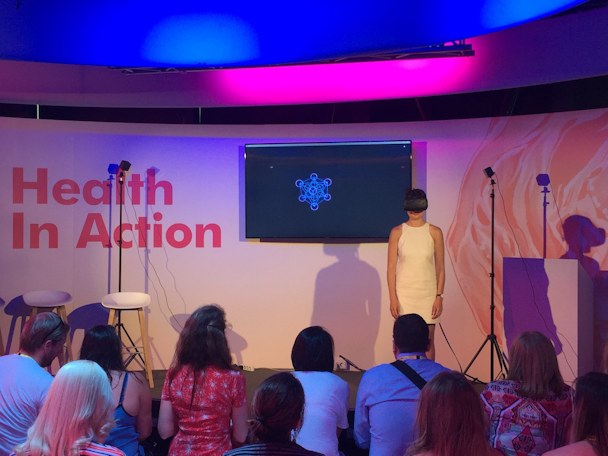Behind Time Inc's 'valuable' VR tool for mental health and wellness
As virtual realty (VR) continues to develop its portfolio of use cases outside of big, bold and flashy consumer applications, the medical field is further identifying ways to use the technology in practical ways.

Mia Tramz, managing editor of Life VR, shows Lumen project at Cannes Lions
During the Cannes Lions Health program, leaders from Time Inc., Framestore and Stanford University presented an intriguing usage of VR technology related to mental health and wellness.
Lumen, demoed at Cannes by Mia Tramz, managing editor of Life VR, Time Inc.’s VR initiative, is an elegant, self-guided, non-linear meditation tool intended to serve as a way to encourage wellness and mindfulness, two important assets to managing stress and stressful situations. The collaboration, bringing together the venerable publisher, highly-awarded creative shop and leading medical program appears to have scope outside of a consumer base hungry for VR content.
VR in the medical field continues to emerge and there are several documented uses that can serve as educational tools, including the first VR surgery in London last year, but using the technology for the patient experience is one area that continues to gain traction. According to Dr. Walter Greenleaf, research neuroscientist and medical product developer at Stanford, medicine and, specifically, training, clinical assessment, intervention and heath and wellness will be transformed by VR.
Built on the Unity gaming platform, Lumen addresses the latter and has been put to practical use in Project Brave Heart, a program at Stanford designed to ascertain the effectiveness of VR in preparing pediatric cardiology patients. The goal is to determine whether or not the pre-procedure VR experience improves the stress and anxiety levels of patients. By walking patients through the process, the idea is that it strips away some of the unknown factors related to serious surgery in turn, lowering stress and anxiety levels.
Greenleaf and his team are currently determining whether or not the program creates better clinical outcomes and continue to compile data from the study, which began in March 2017. According to Dr. Anne Dubin, Stanford professor of pediatrics, anecdotal statements from patients and families has been positive and all find value in the program, especially related to “stress inoculation.”
Much like this specific project, VR itself is relatively nascent and Greenleaf, who mentioned that he has 30 years of experience in the medical technology space, sees that it will take time and education to get it to a more critical mass state.
“We've always had people right from the beginning, who thought a computer would be a barrier between the new patients, and they didn't want to have a computer in the exam room. Now, if you don't have a computer, patients are [wondering why physicians are] not up on the latest thing,” said Greenleaf. “It’s the same with VR. Not very many people are familiar with it, and have tried it. And in terms of validated results, we haven't really done a good job of reincarnating what we've learned from past generations of VR, to their current platforms.”
Additionally, as with any new technology or technique, those using the platform, claiming therapeutic or medical results, could muddy the waters and Greenleaf believes that validation is paramount, though keeping those kinds of developers at bay may be tough.
“I think it's going to be beyond our control, to be honest with you,” he said. “At some point in the next five years, there's going be so many people that have mobile VR systems, and they're going to be able to download a lot of junk that hasn't been validated. In Europe and in the US, there will be a step-by-step (validation) process, but I think the rest of the world will just jump in and start using it. I'm a little worried about that.”
For their part, Tramz and Time Inc. are taking a more metered approach, seeing where it can evolve in more meaningful ways.
“For any project that I've worked on, I follow it intuitively,” said Tramz. “We tend to follow those cues, try and see what fits. It’s more of a gradual process, but we’re pretty confident.”
At the moment, though, Lumen is proving to be a valuable tool and appears to be carving out its own, impressive story, including the requisite data to validate its potential.
“There’s good karma in this project,” said Guillaume Raffi, executive producer at Framestore. “[Time, Inc.] was very open to our contributions and it is a very good collaboration and is something important for the kids [at Stanford].”
Future use of the tool is still being determined, and there are several discussions about how it can be leveraged in other ways. Getting to the next step, however, will require funding and, for the Stanford project, chip-maker AMD stepped in to help see the Brave Heart project through.
“Funding is the biggest challenge,” said Tramz. “We want to develop it for many other platforms; that'll come with a price point.”
Greenleaf, however, believes that there is already one massive part of the industry that could make its way into the space.
“Right now, the consumer electronic companies are spending billions of dollars on this platform and games aren't going to be enough,” he said. “So VR will translate over to the enterprise, and one of the enterprises will be medicine.”

